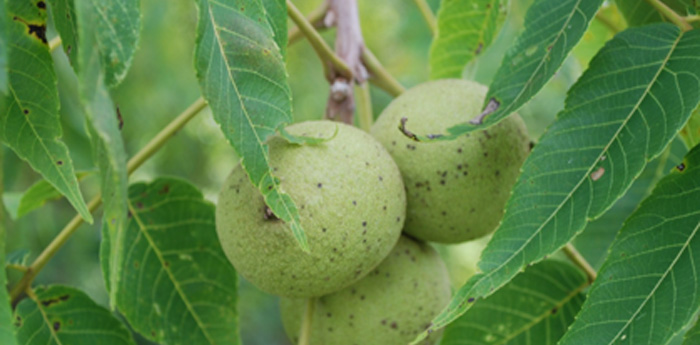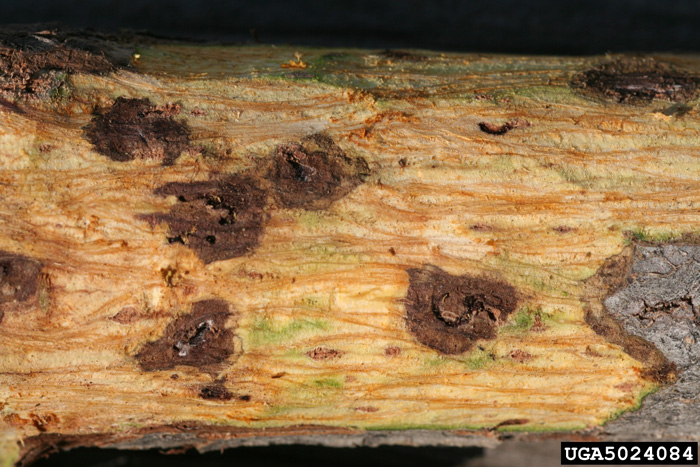Thousand Cankers Disease

Picture of Healthy Black Walnut
Photograph by: Leo Donovall, Pennsylvania Dept of Agriculture
The Pennsylvania Department of Agriculture is responsible for the identification of plants/weeds, insects and mites, nematodes, fungi, bacteria and viruses that impact Pennsylvania's natural resources, abundant flora and economy. On Aug. 9, 2011, the department in cooperation with the U.S. Department of Agriculture and Penn State Cooperative Extension confirmed the presence of Thousand Cankers Disease in black walnut trees in Bucks County.
Effective January 15, 2022, the Pennsylvania Department of Agriculture, Bureau of Plant Industry, has repealed the Order of Quarantine imposed on the plant pest Thousand Cankers Disease (TCD). The decision rescinds the classification of TCD, the fungus Geosmithia morbida, and the walnut twig beetle (WTB), Pityophthorus juglandis, as a public nuisance and a plant pest, are bared on the following information:
- Native populations of Juglans nigra (black walnut) in the eastern United States have been largely unaffected by TCD despite detections of the beetle and/or fungus in nine states (Moore et al., 2019; Seybold et al., 2019).
- Moore, M., Juzwik, J., Miller, F., Roberts, L., and Ginzel, M.D. 2019. Detection of Geosmithia morbida on numerous insect species in four eastern states. Plant Health Prog. 20:133—139.
- Seybold, S.J., Klingeman, W.E., III, Hishinuma, S.M., Coleman, T.W., and Graves, A.D. 2019. Status and impact of walnut twig beetle in urban forest, orchard, and native forest ecosystems. J. For. 117:152—163.
- Based on survey results in Tennessee and Virginia, the percentages of black walnut trees with slight, moderate and severe TCD remained the same for 3 years (Griffin, 2015).
- Griffin, G.J. Status of thousand cankers disease on eastern black walnut in the eastern United States at two locations over 3 years. For. Path. 45 (2015) 203—214.
- The outbreaks of TCD in Tennessee and Virginia appear to be partially a result of drought stress of the trees in 2011-2012 (Griffin, 2015).
- High precipitation levels and high soil water potentials in 2013 were associated with extensive new foliage and stem growth and recovery from TCD (Griffin, 2015).
- It is possible that TCD has been repeatedly introduced into the eastern United States and/or the fungus may be endemic nationwide as suggested by the widespread presence of Geosmithia spp. in other parts of the United States (Huang et al., 2019).
- Huang, Y.T., Skelton, J., Johnson, A.J., Kola|Ahrík M., and Hulcr, J. (2019). Geosmithia species in southeastern USA and their affinity to beetle vectors and tree hosts. Fungal Ecol. 39, 168—183. doi: 10.1016/j.funeco.2019. 02.005.
- Castrillo et al. (2017) demonstrated that treatment of logs with the commercially available entomopathogenic fungal pathogens, Beauvaria bassiana or Metarhizium brunneum, provided suitable control of WTB populations. Similarly, Mayfield et al. (2019) tested Beauvaria bassiana as well as a synthetic pyrethroid against WTB infection of black walnut and found similar results.
- Castrillo, L.A., A.E Mayfield III, M.H. Griggs, R. Camp, B. Mudder, A. Taylor, and J.D. Vandenberg. 2017. Mortality and reduced brood production in walnut twig beetles, Pityophthorus juglandis (Coleoptera: Curculionidae), following exposure to commercial strains of entomopathogenic fungi Beauveria bassiana and Metarhizium brunneum. Biol. Control. 114: 79—86.
Thousand Cankers Disease is caused when Walnut Twig Beetles, which carry a fungus (Geosmithia morbida), tunnel beneath the bark of walnut trees, causing small cankers to form. Over time, repeated beetle attacks and the resulting cankers cause disruption of the movement of water and nutrients throughout the tree, which can lead to dieback of branches but has not been shown to kill the tree.
Early symptoms of the disease are yellowing of leaves and foliage thinning of the upper crown of the tree. Under additional stresses, such as drought conditions, the disease can progress to kill larger limbs, and even the trunk, though this is danger is considerably less likely than originally anticipated.
The Department will continue to work with the Department of Conservation and Natural Resources (DCNR) to monitor and survey throughout the state for outbreaks of walnut twig beetle and possibly Thousand Cankers Disease.
 Diseased limb
Diseased limb
Photograph by: Whitney Cranshaw, Colorado State University, Bugwood.org
Timeline:
- Thousand Cankers Disease (TCD) was described in the western United States in the 1990s, but was not well understood until after 2000.
- Since 2010 TCD has been confirmed in Tennessee, Virginia, Ohio, and North Carolina, showing the disease is spreading beyond the western United States.
- On July 29, 2011, Penn State Plant Disease Clinic received a suspect sample from Bucks County, PA.
- By Aug. 9, 2011 PDA and USDA had confirmation of the presence of both the walnut twig beetle and fungus from Bucks County.
- Agriculture Secretary, George Greig signed a quarantine order on Aug. 10, 2011, stopping the movement of all walnut material and all firewood from Bucks County outward.
- June 23, 2014 PDA and USDA confirmed the presence of both the walnut twig beetle and fungus from Chester County.
- Agriculture Secretary, George Greig signed a new quarantine order on July 22, 2014, to include Bucks, Chester, Delaware, Lancaster, Montgomery and Philadelphia counties.
- Based on survey results and ongoing research that show that TCD damage is both less severe than expected and that Juglans sp., particularly Black Walnut, can recover from infestation, Agriculture Secretary Russel Redding repealed the Order of Quarantine on TCD, effective January 15, 2022.
- PA Department of Agriculture surveys for TCD damage and spread will continue in 2022 and beyond to ensure the long-term health of the Juglans species.
Response:
- With the TCD quarantine repealed, businesses in previously quarantined counties are encouraged to continue inspecting their products for walnut twig beetle. Treatment options are available for walnut twig beetle if they are found. There are also treatment options available for logs for commerce that do not utilize methyl bromide.
- As a result of the research which has been conducted regarding TCD, many states which have TCD quarantines are in process of or have repealed their state quarantines. Please consult with the National Plant Board webpage for changes in quarantine status for states at www.nationalplantboard.org.